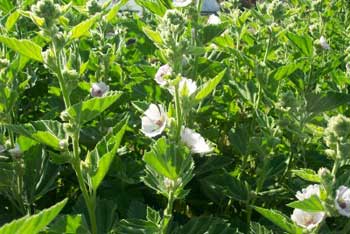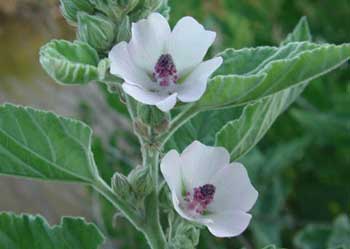Contents:
Common Names | Parts Usually Used | Plant(s) & Culture | Where Found | Medicinal Properties | Biochemical Information
Legends, Myths and Stories | Uses | Formulas or Dosages | How Sold | Bibliography
Scientific Names

- Althaea officinalis L.
- Malvaceae
- Mallow family
Common Names
- Althea
- Mallards
- Marshmallow
- Mortification root
- Schloss tea
- Sweet weed
Parts Usually Used
Dried root, dried leaves and dried flowers.
Back to Top
Description of Plant(s) and Culture

A densely velvety, gray-white perennial plant over 5 feet tall, with erect leafy stems and a thick taproot. The lower, 5-lobed, leaves are long-stalked and lobed, heart-shaped, upper ones folded like a fan. The pale pink (or mauvish) or white flowers grow on small clusters in leaf axils of upper leaves; they have velvety sepals, appear at the height of summer. Fruits are brown-green, downy nutlets. Grown in full sun. Not heat tolerant.
Not to be confused with High Mallow (M. sylvestris L.) or Common Mallow (M. neglecta Wallr).
Back to Top
Where Found
Found in salt marshes on the Atlantic coast, less commonly inland on damp, saline soils, in wet places. Also cultivated. Quebec to Virginia. Native to Europe.
Back to Top
Medicinal Properties
Tonic, nutritive, alterative, diuretic, demulcent, emollient, mucilaginous, vulnerary (heals wounds), laxative, inflammatory; flowers are expectorant
Back to Top
Biochemical Information
Starch, mucilage, pectin, oil, sugar, asparagin. tannin, polysaccharides, flavonoids, the leaves have salicylic and other phenolic acids.
Back to Top
Legends, Myths and Stories
Taking its botanical name from a Greek word, altho, meaning “to heal”, marshmallow has been used since Ancient Egyptian times. The root, rich in sugars, is very mucilaginous and softening for the tissues. The leaves are not as mucilaginous as the root and are used as an expectorant and as a soothing remedy for the urinary system. Both the leaves and the root have been used as a vegetable. All members of the mallow family have similar properties, with varieties such as garden hollyhocks and common mallows occasionally used medicinally.
King Charlemagne (AD 742-814) insisted that marsh mallow be planted throughout his kingdom to ensure an abundant supply. About 800 years after Charlemagne’s death, Culpeper wrote that his son suffered from a disease called the “bloody flux” which the College of Physicians back then called the plague in the guts. Culpeper treated his son by giving him “mallow bruised and boiled both in milk and drink.” Two days later, his son was cured.
Back to Top
Uses
Marsh Mallow is used to treat wasting diseases, tuberculosis, diabetes, cough, pleurisy, dryness and inflammation of the lungs, bronchitis, gangrene, septicemia, ulcers, enteritis, colitis, pain of kidney stones, difficult or painful urination, diarrhea, dysentery, conjunctivitis, rheumatism, gravel in kidneys, blood in the urine, stool, or nose; and vomiting or spitting of blood. Also used as a gargle for sore throats, coughs, whooping cough, laryngitis, bronchitis, mastitis, malnutrition, and sore mouths, externally as a poultice for burns, skin eruptions, wounds, bee stings, cuts and boils. It will also release retained afterbirth.
Back to Top
Formulas or Dosages
Marsh mallow root tea has to be made with cold water. For this reason it is ill suited as a component of tea blends that are brewed with hot water.
After drying, store in air-tight container.
In all cases, prepare a standard infusion or a decoction from several finely diced roots. Either preparation, applied externally, will reduce inflammation, and decoction is said to relieve soreness in the breasts.
Infusion: 1 tsp. dried herb in 1 cup water, simmer for 10 minutes, let stand until cool. Drink 1 to 2 cups a day, in large mouthful doses.
Back to Top
How Sold
Capsules: take 1 capsule, up to 3 times daily to relieve symptoms.
Dried Herb: mix 1 tbsp. of dried herb in 8 oz. boiling water; strain. Drink up to 3 cups of this tea daily to relieve symptoms.
Back to Top
Bibliography
Herbal Gardening, compiled by The Robison York State Herb Garden, Cornell Plantations, Matthaei Botanical Gardens of the University of Michigan, University of California Botanical Garden, Berkeley., Pantheon Books, Knopf Publishing Group, New York, 1994, first edition
 The Magic of Herbs
The Magic of Herbs, by David Conway, published by Jonathan Cape, Thirty Bedford Square, London, England. (Out of print)
 Old Ways Rediscovered
Old Ways Rediscovered, by Clarence Meyer, Meyerbooks, publisher, PO Box 427, Glenwood, Illinois 60425, published from 1954, print 1988
 Earl Mindell’s Herb Bible
Earl Mindell’s Herb Bible, by Earl Mindell, R.Ph., Ph.D., Simon & Schuster/Fireside, Rockefeller Center 1230 Avenue of the Americas, New York, New York 10020
![]() Back to Eden
Back to Eden, by Jethro Kloss; Back to Eden Publishing Co., Loma Linda, CA 92354, Original copyright 1939, revised edition 1994
![]() The Herbalist Almanac
The Herbalist Almanac, by Clarence Meyer, Meyerbooks, publisher, PO Box 427, Glenwood, Illinois 60425, copyright 1988, fifth printing, 1994
![]() Indian Herbalogy of North America
Indian Herbalogy of North America, by Alma R. Hutchens, Shambala Publications, Inc., Horticultural Hall, 300 Massachusetts Avenue, Boston, Massachusetts 02115, 1973
![]() Culpeper’s Complete Herbal & English Physician: Updated With 117 Modern Herbs
Culpeper’s Complete Herbal & English Physician: Updated With 117 Modern Herbs, by Nicholas Culpeper, Meyerbooks, publisher, PO Box 427, Glenwood, Illinois 60425, 1990, (reprint of 1814)
![]() The Complete Medicinal Herbal
The Complete Medicinal Herbal, by Penelope Ody, Dorling Kindersley, Inc, 232 Madison Avenue, New York, NY 10016, First American Edition, copyright 1993
![]() The Herb Book
The Herb Book, by John Lust, Bantam Books, 666 Fifth Avenue, New York, NY. copyright 1974.
![]() Planetary Herbology
Planetary Herbology, by Michael Tierra, C.A., N.D., O.M.D., Lotus Press, PO Box 325, Twin Lakes. WI 53181., Copyright 1988, published 1992
![]() American Folk Medicine
American Folk Medicine, by Clarence Meyer, Meyerbooks, publisher, PO Box 427, Glenwood, Illinois 60425, 1973
![]() Eastern/Central Medicinal Plants
Eastern/Central Medicinal Plants, by Steven Foster and James A. Duke., Houghton Mifflin Company, 215 Park Avenue South, New York, NY 10000
 Taber’s Cyclopedic Medical Dictionary
Taber’s Cyclopedic Medical Dictionary, 15th Edition, F. A. Davis Company, 1915 Arch Street, Philadelphia, PA 19103
![]() Webster’s New World Dictionary
Webster’s New World Dictionary, Third College Edition, Victoria Neufeldt, Editor in Chief, New World Dictionaries: A Division of Simon & Schuster, Inc., 15 Columbus Circle, New York, NY 10023
 An Instant Guide to Medicinal Plants
An Instant Guide to Medicinal Plants, by Pamela Forey and Ruth Lindsay, Crescent Books (January 27, 1992).
 Secrets of the Chinese Herbalists
Secrets of the Chinese Herbalists, by Richard Lucas, Parker Publishing Company, Inc., West Nyack, NY, 1987.
![]() The Yoga of Herbs: An Ayurvedic Guide to Herbal Medicine
The Yoga of Herbs: An Ayurvedic Guide to Herbal Medicine, by Dr. David Frawley & Dr. Vasant Lad, Lotus Press, Twin Lakes, Wisconsin, Second edition, 1988.
 The Rodale Herb Book: How to Use, Grow, and Buy Nature’s Miracle Plants (An Organic gardening and farming book)
The Rodale Herb Book: How to Use, Grow, and Buy Nature’s Miracle Plants (An Organic gardening and farming book), edited by William H. Hylton, Rodale Press, Inc. Emmaus, PA, 18049., 1974
![]() Country Home Book of Herbs
Country Home Book of Herbs, Meredith Books, Editorial Dept. RW240, 1716 Locust Street, Des Moines, IA 50309-3023, copyright 1994
 The Healing Plants
The Healing Plants, by Mannfried Pahlow, Barron’s Educational Series, Inc. 250 Wireless Blvd., Hauppauge, NY 11788, 1992
